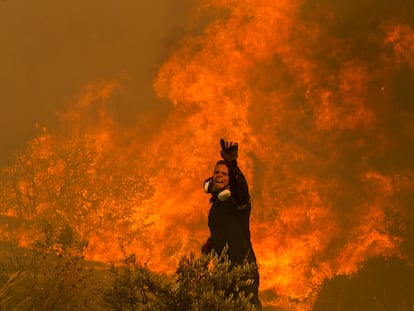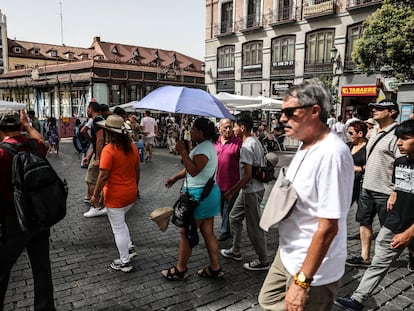Study suggests global warming set to worsen snow shortages on Europe’s ski slopes
Repeated and increasing wintertime thaws have saddled many European ski resorts in recent years, leaving many slopes worryingly bare of snow

A scientific study published Monday projects that over half of Europe’s ski resorts will face a severe lack of snow if temperatures rise 2 degrees Celsius above pre-industrial levels, while nearly all would be affected by an increase of 4 degrees — presenting challenges for the industry and policymakers, and threatening a harsher reality for ski lovers.
In the paper in the journal Nature Climate Change, the team of experts warns that a common solution — production of artificial snow – would only partially offset the decline and would involve processes like snow blowers that generate more of the same greenhouse gases that are heating up the globe in the first place.
Repeated and increasing wintertime thaws have saddled many European ski resorts in recent years, leaving many slopes worryingly bare of snow. Along with glacier melt, snow shortages have become a visible emblem of the effects of climate change. Everything from basic tourism to pro ski competitions have felt the effects.
The new study suggests things could get much worse.
With the rise in global temperatures already flirting with the target limit of 1.5 degrees under the 2015 Paris climate accord, and a higher climb seemingly inevitable, the researchers analyzed the impact on more than 2,200 ski resorts across 28 European countries.
The research evaluated changes in snow cover across a range of increases in temperature: 53% of ski resorts in Europe would face “very high risk of insufficient snow” at a rise of 2 degree Celsius. Nearly all — 98% — would face that level of risk if the 4-degree bar is surpassed.
Even with use of artificial snow, more than one-fourth of the resorts would still face snow shortages if temperatures rise by 2 degrees, and more than 70 percent would if they climb by 4 degrees, the forecasters said.
The researchers say their paper goes further than previous country-specific studies and provides a first comprehensive look at the impact of snow shortages on the slopes across Europe, home to half of the world’s ski resorts.
“What this study also provides is an analysis of the water requirement, electricity requirement, and greenhouse gas emissions that are associated with snowmaking,” said co-author Samuel Morin, a researcher with weather forecaster Meteo France.
As with most efforts to combat climate change, tourism officials and government leaders will likely need to respond with a mix of attenuation — trying to keep temperatures from rising — and adaptation: changing behavior for a new reality in places like Spain’s Pyrenees, Norway’s Mount Trysilfjellet, the Swiss Alps, or Turkey’s Erciyes resort.
“In the tourism sector, if we want to limit the extent of the consequences (of climate change), we must also be concerned about limiting the carbon footprint of this activity — and therefore do everything possible to massively reduce greenhouse gas emissions for the entire sector,” Morin said.
Ruth Mottram, a climate scientist at the Danish Meteorological Institute, called it a “really interesting and very thorough” study, praising its examination of climate as well as adaptations in water, electricity and carbon footprints and its look at past changes in temperatures that formed a basis for the forecast.
She noted how the report suggests use of renewable energy “makes it considerably more feasible to adapt by continuing snowmaking without producing too much additional carbon,” but it also suggested that transport to ski slopes appeared to be an important source of emissions — and greener snowmaking will have no impact on that.
“Overall, it looks like European skiers will be able to continue skiing, but the activity will migrate further north and higher up the mountains, even with additional investment in snowmaking,” Mottram wrote in an email.
Many ski resort operators — in Europe and beyond — are already getting the message, and may need to do more.
Anita Verpe Dyrrdal, a research scientist at the Norwegian Meteorological Institute, said the study’s prediction for a drop in “snow reliability index” in Norway was in line with national assessments. She applauded the research for its snow modeling and energy production estimates, but acknowledged it might overlook some specifics.
“My concern is in the spatial resolution of the model simulations, which, especially in topographic regions, might be too coarse,” she said, alluding to sharp changes in altitude that might not be seen in the researchers’ modeling, such as near Norway’s fjords, or wind conditions that could cause snow to drift.
“Local snow modeling might be important in some regions where local effects play a big role,” she said.
For skiers, the study suggests higher — and colder — destinations may be required to get to the best slopes, and suggested one takeaway from the study was that resorts that assess their local conditions and adapt as necessary might in fact lure more skiers in the years to come.
“The most robust ski locations in the future might attract even more tourists?” she mused.
Sign up for our weekly newsletter to get more English-language news coverage from EL PAÍS USA Edition
Tu suscripción se está usando en otro dispositivo
¿Quieres añadir otro usuario a tu suscripción?
Si continúas leyendo en este dispositivo, no se podrá leer en el otro.
FlechaTu suscripción se está usando en otro dispositivo y solo puedes acceder a EL PAÍS desde un dispositivo a la vez.
Si quieres compartir tu cuenta, cambia tu suscripción a la modalidad Premium, así podrás añadir otro usuario. Cada uno accederá con su propia cuenta de email, lo que os permitirá personalizar vuestra experiencia en EL PAÍS.
¿Tienes una suscripción de empresa? Accede aquí para contratar más cuentas.
En el caso de no saber quién está usando tu cuenta, te recomendamos cambiar tu contraseña aquí.
Si decides continuar compartiendo tu cuenta, este mensaje se mostrará en tu dispositivo y en el de la otra persona que está usando tu cuenta de forma indefinida, afectando a tu experiencia de lectura. Puedes consultar aquí los términos y condiciones de la suscripción digital.
More information
Últimas noticias
Sydney Sweeney, the actress praised by Trump: ‘Women are up against what society wants them to be’
The Bolsonaro surname: An advantage or liability in Brazil’s 2026 presidential elections?
Raúl Rocha, from jet-setting with Miss Universe to arms trafficking and fuel theft
80,000 barrels of Mexican oil sent to Cuba: Havana drawn into the US–Mexico clash
Most viewed
- Reinhard Genzel, Nobel laureate in physics: ‘One-minute videos will never give you the truth’
- Pablo Escobar’s hippos: A serious environmental problem, 40 years on
- Charles Dubouloz, mountaineering star, retires at 36 with a farewell tour inspired by Walter Bonatti
- Why we lost the habit of sleeping in two segments and how that changed our sense of time
- The fall of a prolific science journal exposes the billion-dollar profits of scientific publishing










































